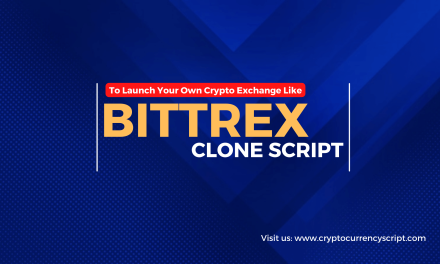Bitcoin has been gaining popularity and usage since its inception. It is known for having a higher transaction activity than most other cryptocurrencies, with the exception of ETH.
In May 2023, the network processed over 670,000 coins in a single day, which was the highest transaction volume to date. These statistics indicate that the number of users is likely to continue to increase in the future.
As the number of users increases, so does the demand for trading platforms. Starting your own Bitcoin exchange can help you create a separate user base and generate more profit with a revenue stream.
However, before you can create such a platform, it is important to understand its features, benefits, and finally how to start your own Bitcoin exchange.
Let’s begin with…
Understanding the Bitcoin Exchange
Bitcoin exchange is a digital platform that enables investors and traders to buy, sell, stake, and trade bitcoins using a range of tools and features. The platform also allows users to swap their Bitcoins for other assets.
Similar to stock exchanges, Bitcoin exchanges facilitate the buying and selling of assets. However, these exchanges are exclusive to Bitcoin traders and use blockchain technology to ensure secure and transparent transactions.
Users can employ various trading strategies such as margin, spot, derivatives, and P2P on the platform. To get started, users need to create an account with a Bitcoin exchange and complete the KYC process. Once verified, they can freely trade Bitcoins with other cryptocurrencies or fiat currencies using a variety of strategies.
Working Model of Bitcoin Exchange
A functional model of a Bitcoin exchange is contingent upon the design choices made by its owner, and the specific type of exchange determines the platform’s features and operations. There are generally four categories of exchanges: centralized, decentralized, hybrid, and peer-to-peer (P2P).
Centralized exchanges rely on administrators and third-party entities to facilitate transactions, with examples such as Binance and Coinbase.
Decentralized exchanges operate autonomously, eliminating third-party involvement; UniSwap and PancakeSwap are notable examples.
Hybrid exchanges aim to combine the convenience of centralized exchanges with the security of decentralized ones. Example IDEX.
P2P exchanges operate in a peer-to-peer manner, leveraging a smart contract-based escrow system. Example Paxful, LocalBitcoins
Bitcoin exchanges operate in two primary ways:
#1. Fiat-to-Bitcoin
This type of exchange facilitates the trading of fiat currency for Bitcoin and vice versa.
#2. Crypto-to-Bitcoin
In this exchange, users can trade alternative cryptocurrencies (altcoins) with Bitcoin or vice versa.
For all active traders, Bitcoin exchanges serve as the gateway to participate in the marketplace. The owner of the platform makes it an attractive business opportunity to generate profit.
To smooth your profit flow, the solution you build should have some default elements. We will see some of the important elements further in the discussion.
Related Article: How to Build Your Bitcoin Exchange
Key Elements of Bitcoin Exchange Software
The functionality of your Bitcoin exchange software is determined by the type of platform you opt for. Different platforms come with different features, and for illustration, let’s examine the key elements found in centralized Bitcoin exchange software.
#1. User enrollment
Allow users to enroll and authenticate to sign up and start their trading process on their platforms.
#2. Security measures
Incorporates advanced security measures like KYC, 2FA, reCaptcha, etc at multiple levels to safeguard the platform.
#3. User-friendly interface
Users will trade, access their wallets, and modify account information in this visually appealing place.
#4. Matching Engine
Enables a Bitcoin exchange to function and manage all open trade order books on the crypto market.
#5. Market liquidity
The value of a Bitcoin exchange is primarily determined by how easily users buy or sell Bitcoins without price fluctuations.
#6. Wallet integration
Seamless integration with Bitcoin wallets is facilitated to enable users to securely store and manage their digital assets.
To start your own Bitcoin exchanges, you should have these attributes in your software. And these elements are indispensable, as they represent the standard offerings across most platforms.
Emphasizing these things on your platform is beneficial not only to users but also to owners. You can tailor the fee structure based on the service you provide. Besides making a profit, there are some other benefits of running your own Bitcoin exchange platform.
Benefits of Starting Your Own Bitcoin Exchange
Bitcoin exchange platform owners and investors can reap numerous benefits by starting a cryptocurrency exchange. Let’s explore some of the most significant benefits here:
Market Exposure
Starting a Bitcoin exchange also provides insider benefits to a rapidly expanding crypto industry. You can gain direct market exposure to all the developments taking place in the industry.
Access to Liquidity
As an exchange owner, you can access liquidity pools, which can be beneficial for trading on your platform and for liquidity partnerships with other exchanges.
Joining the Crypto Market
Bitcoin transactions have become ubiquitous in almost every industry worldwide. As of 2023, Bitcoin’s (BTC) market capitalization stands at $814 billion, representing its 50.82% dominance.
Therefore, if you start your own Bitcoin exchange, it will provide you with a front-row seat to witness the growth of the crypto industry. As the industry becomes more profitable and sophisticated, it will create more opportunities for your business growth.
Hope you understand all the basics about the Bitcoin exchange we have discussed so far. After reading all this, some may have a question like how long does it take to create your own Bitcoin exchange.
How Long Does It Take To Start Your Own Bitcoin Exchange?
Starting a Bitcoin exchange platform can be done in two ways – building one from scratch or using a Bitcoin exchange script. If you choose to build an exchange from the ground up, it can take several months to a year to complete. The development process involves several steps such as initialization, design, development, testing, and deployment.
On the other hand, using a ready-to-use solution allows for immediate deployment with minimal customization. Both methods are efficient and offer their benefits based on the budget of the startup founders. Ultimately, the development costs can vary depending on various factors and the packages that are offered by a cryptocurrency exchange development company like Zodeak. If you have any queries feel free to reach out to our experts for unbiased answers.





